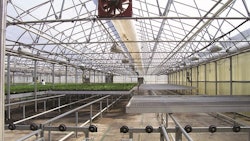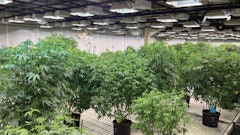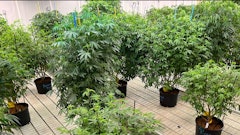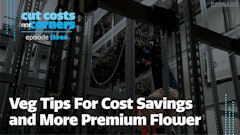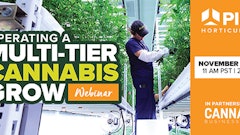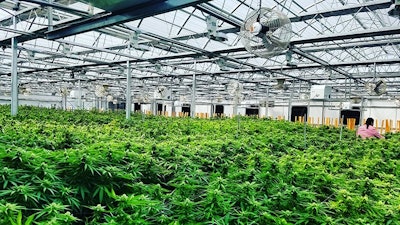
My name is Max, but you might know me by my alias, One Eye Max. I lost my eye at age 12 in a stick fight. In 1999, at the age of 16, I became one of the youngest licensed medical marijuana card holders in the United States. I have been growing cannabis legally ever since.
Today, I am the working owner and production manager at Aroma Cannabis, a Tier 2 Licensed cultivation facility located in Canby, Ore. We operate in a fully automated, commercial greenhouse that is roughly 12,000 square feet. We harvest about 1,600 plants every 30 days and have up to 9,000 plants in the greenhouse at any given time.
Learning to grow kind bud is crucial, but it’s a small piece of the pie. The years I spent cultivating prior to expanding into a larger-scale operation gave me great confidence, but working with my partners to design a business plan served as a crash course in business, to say the least. There was a lot I didn’t know. In hindsight, there were some things I would have done differently. To help you avoid the same mistakes that I made, I am thrilled to share my humble experience and tips on scaling from a home grow or other small-scale grow to a commercial production facility.
BUSINESS PLAN
TIP: When putting your plan together, it’s good to be as realistic and conservative with your expectations as possible. A wealth of data is now available, so you can learn from all those who have jumped in before you. When we first received our license to operate from the state of Oregon, wholesale prices were still above $2,000 per pound. Now, a little over a year later, prices are less than half of that. Know that this industry is a roller coaster.
TIP: Whatever your expected timeline and budget is, double it. Challenges with licensing, permits, site build-out and power companies are inevitable, and unforeseeable bumps in the road are probable.
TIP: It is essential to know your customer to help you carve out a niche, based on their demands. What is your unique angle in the market? This may have a big impact on your design and site build-out process. For instance, I have industry friends who only grow outdoors and strictly for processing for concentrates. They spend a fraction of the cost on infrastructure that a boutique indoor grower will. They do not need an environmentally controlled and sealed environment. But the indoor growers’ products commonly fetch higher market prices because of their more visually appealing attributes. TIP: It is a good idea to find a void in the marketplace and build a production process that fills the need.

THE BUILDING PROCESS
TIP: A knowledgeable and reliable construction team is key. TIP: And not enough can be said for doing your due diligence when it comes to state and local regulation and compliance.
We have had many of the common hang ups: expensive, unforeseen electrical upgrades, county hurdles, over-shot bids, odor-control dilemmas and subcontractor surprises. We went through three electrical contractors before final inspection. When you are working in a new industry, experience is going to be limited. With our county, several ordinances were set in place in addition to the state compliance. I could not find a mechanical engineer who would satisfy the odor compliance, which stated there could be no cannabis smell at any property line. It took me several months of research and sleeplessness before eventual success. This problem alone made my investor want to ditch the greenhouse in favor of an outdoor grow, which does not carry the same county ordinances. But thankfully, the greenhouse construction ensued.
As for electricians, their limited experience in wiring a fully automated cannabis greenhouse was painful. My environmental control module was wired incorrectly at install and caused half my lights and blackout curtains to open at odd times of the day and night—not ideal for our short-day plants. When the electricians admitted no fault, I acquired a more experienced outfit. In fact, three electricians tried their hands at control room wiring before it worked as intended. TIP: All of this underscored the importance of contracts, liabilities and warranties. TIP: Know who is fixing the problem when it undoubtedly occurs, and expect problems to happen at the worst possible times. TIP: Quality equipment and quality subcontractors are essential in the long run. It’s sadly common to hear stories of construction blunders leaving a once-optimistic entrepreneur on his heels as weeks turn to months of delayed harvests.
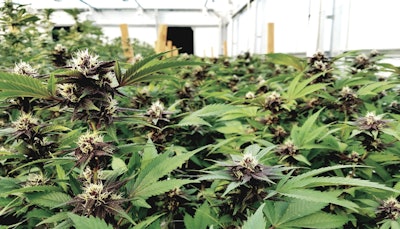
FACILITY DESIGN
It doesn’t matter if you grow inside an industrial building, on a 40,000-square-foot outdoor hillside or in a greenhouse. TIP: Knowing how to achieve your optimum environment is a must. And doing so efficiently and effectively will pay valuable dividends immediately.
I have asked more questions and learned more in the last year—during facility design, build-out and cultivating our first crops—than in all my previous years of cultivation combined. What’s the best light and why? Best nutrient line and media? Everybody sells the “new best thing” in the cannabis industry. It’s a product overload out there. TIP: Even though we have full automation in the greenhouse, keeping the facility simple has been beneficial. A common conundrum will present itself at all stages of operation—from when you design your lighting layout to learning about the newest creepy crawly in your rhizosphere. TIP: Learn as much about the task at hand, then ask the same question to as many experts as possible. Ideally, you are left making the best-educated decision. I have sought much expertise on every aspect of the operation, and I am intent on continuing to build a network of very knowledgeable professionals. TIP: Build networks of people you trust to help along the way.
TEAM BUILDING
Once your site is built, it’s time to hire your dream team. How many people do you need to hire? Labor has been my highest operational cost by far. TIP: Knowing task timelines and workflow is a valuable tool. How many labor hours does it take to transplant 1,700 plants? Take 2,000 clones? Trim 150 pounds? Erik, my general manager, and I study data, run scenarios and record numbers constantly. When prices fell and supply went through the roof, we ferociously dissected our budgets and costs. We have dropped our operating budget by 40 percent this year.
Jumping into a manager/owner role has been interesting and consuming at times. If you have never managed people, prepare for an adventure. I have up to 16 full-time employees at a time. I have had over 30 employees come and go since the beginning. Managing people is challenging. Plenty of people think they want to work at a cannabis farm, but the honeymoon eventually wears off and people bail when all that’s left is farm labor.
At Aroma, we have evolved our hiring practices and expectations. TIP: We are upfront and clear about what we need out of an employee. We have landed a great core team now, and the whole garden moves in unison. It’s wonderful. TIP: It is tough to find good help, but when you do, hold on to them. Nothing short of an amazing team will do.
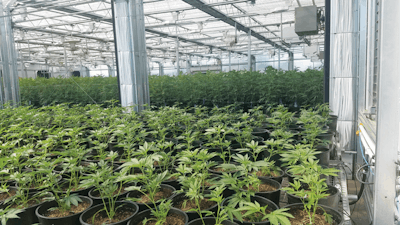
OPERATION
After completing all the above, you’ve made it to full-blown operation and are loving it. Everything seems to be going according to plan. This first crop is going to be glorious. Oops, OK, maybe not. But the next one will be. Dang it. Well, surely the next harvest will. …
Hiccups are bound to occur, so expect a learning curve and be prepared to work a lot. TIP: Think of yourself as a firefighter—problem solving in volume daily. An ounce of prevention is worth a pound of cure. (Thank you, Benjamin Franklin, for that gem.)
Additionally, be clean. TIP: In fact, strive to be surgical-sterile at your facility.
TIP: Have integrated pest management (IPM) programs and then IPM programs for your IPM programs. You’re about to learn a lot about bugs, both good and bad.
A great benefit to scaling up is the education you will receive. Having a large commercial arena has allowed me the ability to experiment with all kinds of variables. Experiments are fun when they work. TIP: Gamble at your own risk, learn your market and stay current. Talk to intake managers and stay in tune with what the market is doing. Be humble and respectful; doors open when you are kind and realistic.
TIP: Lastly, brand yourself. Cannabis folks are great at branding, and it will be necessary to stand out amongst the herd.
I wish you luck in your cannabis adventure!









